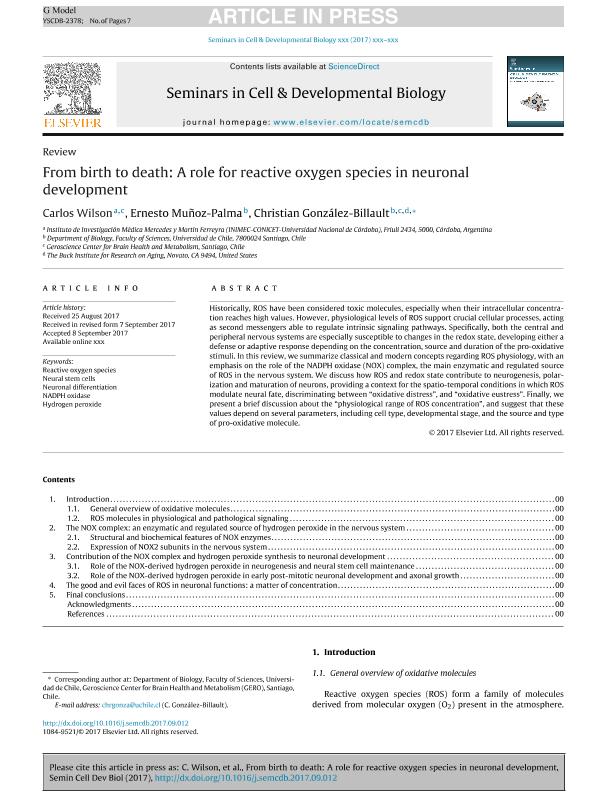Mostrar el registro sencillo del ítem
dc.contributor.author
Wilson Rodriguez, Carlos

dc.contributor.author
Muñoz Palma, Ernesto
dc.contributor.author
González Billault, Christian

dc.date.available
2018-11-02T14:43:55Z
dc.date.issued
2017-09-09
dc.identifier.citation
Wilson Rodriguez, Carlos; Muñoz Palma, Ernesto; González Billault, Christian; From birth to death: A role for reactive oxygen species in neuronal development; Academic Press Ltd - Elsevier Science Ltd; Seminars In Cell & Developmental Biology; 80; 9-9-2017; 43-49
dc.identifier.issn
1084-9521
dc.identifier.uri
http://hdl.handle.net/11336/63508
dc.description.abstract
Historically, ROS have been considered toxic molecules, especially when their intracellular concentration reaches high values. However, physiological levels of ROS support crucial cellular processes, acting as second messengers able to regulate intrinsic signaling pathways. Specifically, both the central and peripheral nervous systems are especially susceptible to changes in the redox state, developing either a defense or adaptive response depending on the concentration, source and duration of the pro-oxidative stimuli. In this review, we summarize classical and modern concepts regarding ROS physiology, with an emphasis on the role of the NADPH oxidase (NOX) complex, the main enzymatic and regulated source of ROS in the nervous system. We discuss how ROS and redox state contribute to neurogenesis, polarization and maturation of neurons, providing a context for the spatio-temporal conditions in which ROS modulate neural fate, discriminating between “oxidative distress” and “oxidative eustress”. Finally, we present a brief discussion about the “physiological range of ROS concentration” and suggest that these values depend on several parameters, including cell type, developmental stage, and the source and type of pro-oxidative molecule.
dc.format
application/pdf
dc.language.iso
eng
dc.publisher
Academic Press Ltd - Elsevier Science Ltd

dc.rights
info:eu-repo/semantics/openAccess
dc.rights.uri
https://creativecommons.org/licenses/by-nc-nd/2.5/ar/
dc.subject
Hydrogen Peroxide
dc.subject
Nadph Oxidase
dc.subject
Neural Stem Cells
dc.subject
Neuronal Differentiation
dc.subject
Reactive Oxygen Species
dc.subject.classification
Inmunología

dc.subject.classification
Medicina Básica

dc.subject.classification
CIENCIAS MÉDICAS Y DE LA SALUD

dc.title
From birth to death: A role for reactive oxygen species in neuronal development
dc.type
info:eu-repo/semantics/article
dc.type
info:ar-repo/semantics/artículo
dc.type
info:eu-repo/semantics/publishedVersion
dc.date.updated
2018-10-22T15:52:55Z
dc.identifier.eissn
1096-3634
dc.journal.volume
80
dc.journal.pagination
43-49
dc.journal.pais
Estados Unidos

dc.description.fil
Fil: Wilson Rodriguez, Carlos. Consejo Nacional de Investigaciones Científicas y Técnicas. Centro Científico Tecnológico Conicet - Córdoba. Instituto de Investigación Médica Mercedes y Martín Ferreyra. Universidad Nacional de Córdoba. Instituto de Investigación Médica Mercedes y Martín Ferreyra; Argentina
dc.description.fil
Fil: Muñoz Palma, Ernesto. Universidad de Chile; Chile
dc.description.fil
Fil: González Billault, Christian. Universidad de Chile; Chile. The Buck Institute for Research on Aging; Estados Unidos. Geroscience Center for Brain Health and Metabolism; Chile
dc.journal.title
Seminars In Cell & Developmental Biology

dc.relation.alternativeid
info:eu-repo/semantics/altIdentifier/doi/http://dx.doi.org/10.1016/j.semcdb.2017.09.012
dc.relation.alternativeid
info:eu-repo/semantics/altIdentifier/url/https://www.sciencedirect.com/science/article/pii/S1084952117303348
Archivos asociados
